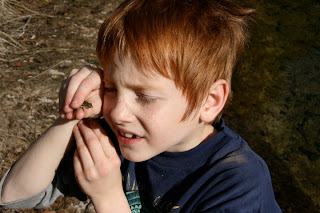
Gabriel sits on the dam at Jacob's Ladder, which is the name of the area and the tank.

Eli shows how slow the water is going over the dam now because we haven't had much rain recently.

Chris, Eli, and Gabriel on the Louis Bromfield Trail which runs along Miller Creek. We started at Jacobs Ladder tank and we were traveling upstream, and the end of the trail for us was across from Hes' Country Store.

Gabriel gets a hug from his dad.

Eli is showing me a tiny frog that he caught on the creek edge.

When Eli tossed the Blanchard's Cricket Frog (Acris cretipans blanchardi) into the creek it swam back to the shore, and I got this nice picture of it next to a Spanish oak leaf that shows how very small it is! According to my guide book, Reptiles and Amphibians of Texas by Garrett and Barker, this little frog is from 5/8" to 1.5" long and its call is a succession of clicks that sound like river rocks being tapped together. It is a common frog that is found in much of Texas, except the far eastern and far western parts of the state. In the warm months, when you walk up to a pond, if you tap rocks together Cricket frogs will frequently answer you. Start your clicking slowly (about once per second, and then gradually increase your speed. Stop after about 5 seconds and listen to hear if you get a response.

Eli found this rock that has a mostly smooth rounded indentation and a few parallel lines that start in the shadow and run about a third of the way across. It could be a fossil, but I don't know what kind it might be.

Gabriel likes to throw rocks into the creek.

The dam across the creek near the snowbell section of the Bromfield Trail has stepping stones so you can cross it easily without getting your feet wet.

Only a small amount of water was flowing a week ago.

During this past summer when we were getting a lot of rain, the amount of water flowing across the dam was considerably greater.

In the winter when the grasses are shades of grey, brown or rust, if you see a plant that looks like a large green grass plant it is probably Nolina lindheimeriana or Sacahuista, also called Beargrass which is in the Agave Family. Its leaves are long, thin and very tough, and Native Americans used them for weaving baskets.

Imagine my surprise when we saw this Bagworm bag, which was on a small Plateau Live Oak near the creek. The bag is made of liveoak leaves which are woven into a silken bag which covers the body of a caterpillar, or larval stage, of the Bagworm moth. The adult male has a dark fuzzy body and clear wings. The adult female doesn't have wings and stays in her bag. A male finds her and after they mate, she produce lots of eggs which stay to hatch in her bag. When the eggs hatch tiny caterpillars lower themselves on threads, find food, and make a tiny bag that they carry around with them. Eventually when they are larger each one makes their own hanging bag and the cycle is repeated.

This egg-case which is a little less than one inch long was made by a female Praying Mantid. It was on a Kidneywood bush and it was easy to see when the leaves were down. There were 100's of eggs in this case and it looks like they hatched out months ago. When I was sitting at a picnic table at Madrone Lake one spring, I noticed hundreds of tiny praying mantids crawling on the top of the table. I looked underneath and could see the eggcase was attached to the picnic table leg. Because Praying Mantids eat insects that eat plants, I was happy to see them.

Spiders like this one are often seen running around during the day. (Animals that are active during the day are diurnal, and the ones that are active at night are nocturnal). It is probably one of a group of spiders known as Wolf Spiders that have good eyesight and hunt for prey insects on foot, or wait for an insect to walk close so they can ambush it.
 In this close-up you can see the spider's 2 large front eyes, which allow them to see well. All spiders have a total of 8 eyes, but in wolf spiders 6 of them are very small.
In this close-up you can see the spider's 2 large front eyes, which allow them to see well. All spiders have a total of 8 eyes, but in wolf spiders 6 of them are very small.Note: Photographs were taken by Margaret Bamberger on a Conon XTi digital single-lens-reflex camera on the 29th of December, 2007.
No comments:
Post a Comment